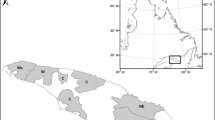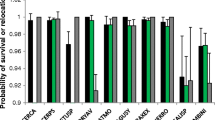Abstract
Direct demographical information from different populations of species in concern may reveal processes to target by management. We estimated seasonal survival rates using data from 253 individual females in a continuous population of black grouse Tetrao tetrix in Central Finland in 2005–2007. The information theoretic model selection included the effects of age class, ecological season, year, and their relevant interactions. We showed a clear difference in the survival of young and older females during late winter, a decrease in female survival during spring, and variation between the study years. The most frequent proximate mortality cause was avian predation, and the avian predation rate was highest in spring.



Similar content being viewed by others
References
Alatalo RV, Höglund J, Sutherland WJ (1992) Evolution of black grouse leks: female preferences benefit males in larger leks. Behav Ecol 3:53–59. doi:10.1093/beheco/3.1.53
Angelstam P (1984) Sexual and seasonal differences in mortality of the black grouse (Tetrao tetrix) in boreal Sweden. Ornis Scand 15:123–124
Arnold TW (2010) Uninformative parameters and model selection using Akaike’s information criterion. J Wildl Manag 74:1175–1178. doi:10.2193/2009-367
Baines D, Warren P, Richardson M (2007) Variations in the vital rates of black grouse Tetrao tetrix in the United Kingdom. Wildl Biol 13:109–116. doi:10.2981/0909-6396(2007)13[109:VITVRO]2.0.CO;2
Barron DG, Brawn JD, Weatherhead PJ (2010) Meta-analysis of transmitter effects on avian behaviour and ecology. Methods Ecol Evol 1:180–187. doi:10.1111/j.2041-210X.2010.00013.x
Bergerud AT (1988a) Population ecology of North American grouse. In: Bergerud AT, Gratson MW (eds) Adaptive strategies and population ecology of northern grouse. Vol. II. Theory and synthesis. University of Minnesota Press, Minneapolis, pp 578–685
Bergerud AT (1988b) Increasing the numbers of grouse. In: Bergerud AT, Gratson MW (eds) Adaptive strategies and population ecology of northern grouse. Vol. II. Theory and synthesis. University of Minnesota Press, Minneapolis, pp 578–685
Burnham KP, Anderson DR (2002) Model selection and multi-model interference: a practical information theoretic approach, 2nd edn. Springer-Verlag Inc, New York
Caizergues A, Ellison LN (1997) Survival of black grouse Tetrao tetrix in the French Alps. Wildl Biol 3:177–186
Caizergues A, Ellison LN (2002) Natal dispersal and its consequences in black grouse Tetrao tetrix. Ibis 144:478–487
Calvo B, Furness RW (1992) A review of the use and the effects of marks and devices on birds. Ringing Migr 13:129–151. doi:10.1080/03078698.1992.9674036
Clobert J, Danchin E, Dhondt AA, Nichols JD (eds) (2001) Dispersal. Oxford University Press, New York
Dinsmore SJ, White GW, Knopf FL (2002) Advanced techniques for modeling avian nest survival. Ecology 83:3476–3488. doi:10.1890/0012-9658(2002)083[3476:ATFMAN]2.0.CO;2
Harshman LG, Zera AJ (2007) The cost of reproduction: the devil in the details. Trends Ecol Evol 22:80–86. doi:10.1016/j.tree.2006.10.008
Helle P, Helle T (1991) How do changes in forest structure explain recent changes in Finnish grouse populations. Suomen Riista 37:55–66. doi:10.1890/0012-9658(2000)081[1985:LFAFCE]2.0.CO;2, In Finnish with English summary
Helminen M (1963) Composition of the Finnish populations of capercaillie, Tetrao urogallus, and black grouse, Lyrulus tetrix, in the autumns of 1952–1961, as revealed by a study of wings. Papers Game Res 23:1–124
Heppel SS, Caswell H, Crowder LB (2000) Life histories and elasticity patterns: perturbation analysis for species with minimal demographic data. Ecology 81:654–665. doi:10.1890/0012-9658(2000)081[0654:LHAEPP]2.0.CO;2
Kenward RE (1978) Hawks and doves: factors affecting success and selection in goshawk attacks on woodpigeons. J Anim Ecol 47:449–460. doi:10.2307/3793
Kenward RE, Marcström V, Karlbom M (1999) Demographic estimates from radio-tagging: models of age-specific survival and breeding in the goshawk. J Anim Ecol 68:1020–1033. doi:10.1046/j.1365-2656.1999.00347.x
Kurki S, Nikula A, Helle P, Lindén H (1998) Abundances of red fox and pine marten in relation to the composition of boreal forest landscapes. J Anim Ecol 67:874–886. doi:10.1046/j.1365-2656.1998.6760874.x
Kurki S, Nikula A, Helle P, Lindén H (2000) Landscape fragmentation and forest composition effects on grouse breeding success in boreal forests. Ecology 81:1985–1997. doi:10.1890/0012-9658(2000)081[1985:LFAFCE]2.0.CO;2
Lampila P, Ranta E, Mönkkönen M, Lindén H, Helle P (2011) Grouse dynamics and harvesting in Kainuu, Northeastern Finland. Oikos 120:1057–1064. doi:10.1111/j.1600-0706.2010.18788.x
Lebigre C, Alatalo RV, Forss HE, Siitari H (2008) Low levels of relatedness on black grouse leks despite male philopatry. Mol Ecol 17:4512–4521. doi:10.1111/j.1365-294X.2008.03926.x
Lebigre C, Alatalo RV, Siitari H (2010) Female-biased dispersal alone can reduce the occurrence of inbreeding in black grouse (Tetrao tetrix). Mol Ecol 19:1929–1939. doi:10.1111/j.1365-294X.2010.04614.x
Lima SL, Dill LM (1990) Behavioural decisions made under the risk of predation: a review and prospectus. Can J Zool 68:619–640. doi:10.1139/z90-092
Lindén H (1981) Estimation of juvenile mortality in the capercaillie Tetrao urogallus and the black grouse T. Tetrix from indirect evidence. Finn Game Res 39:35–51
Lindén H, Wikman M, Helle E (1989) Tetraonid populations in Finland 1988: a comparison between the route censuses and the wildlife triangles. Suomen Riista 35:36–42, In Finnish with English summary
Linden H, Helle E, Helle P, Wikman M (1996) Wildlife triangle scheme in Finland: methods and aims for monitoring wildlife populations. Finn Game Res 49:4–11
Lindström J (1994) Tetraonid population studies—state of the art. Ann Zool Fenn 31:347–364
Ludwig GX (2007) Mechanisms of population declines in boreal forest grouse. Dissertation, University of Jyväskylä
Ludwig GX, Alatalo RV, Helle P, Lindén H, Lindström J, Siitari H (2006) Short- and long-term population dynamical consequences of asymmetric climate change in black grouse. Proc R Soc B 273:2009–2016. doi:10.1098/rspb.2006.3538
Ludwig GX, Alatalo RV, Helle P, Nissinen K, Siitari H (2008) Large-scale drainage and breeding success in boreal forest grouse. J Appl Ecol 45:325–333. doi:10.1111/j.1365-2664.2007.01396.x
Ludwig GX, Alatalo RV, Helle P, Siitari H (2010a) Individual and environmental determinants of early brood survival in black grouse. Wildl Biol 16:367–378. doi:10.2981/10-013
Ludwig GX, Alatalo RV, Helle P, Siitari H (2010b) Individual and environmental determinants of daily black grouse nest survival rates at variable predator densities. Ann Zool Fenn 47:387–397
Magnhagen C (1991) Predation risk as a cost of reproduction. Trends Ecol Evol 6:183–185. doi:10.1016/0169-5347(91)90210-O
Marcström V, Kenward RE, Engren E (1988) The impact of predation on boreal tetraonids during vole cycles: an experimental study. J Anim Ecol 57:859–872
Marcström V, Kenward RE, Karlblom M (1989) Survival of ring-necked pheasants with backpacks, necklaces and leg bands. J Wildl Manag 53:808–810
Marjakangas A (1986) On the winter ecology of the black grouse, Tetrao tetrix, in central Finland. Dissertation, University of Oulu. Acta Univ Oulu A 183:1–87
Marjakangas A, Aspegren H (1991) Responses of black grouse Tetrao tetrix hens to supplemental winter food. Ornis Scand 22:282–283
Marjakangas A, Kiviniemi S (2005) Dispersal and migration of female black grouse Tetrao tetrix in Eastern Central Finland. Ornis Fenn 82:107–116
Marjakangas A, Moss R (1991) The role of nutrition in population regulation of grouse. Ornis Scand 22:295–296
Marjakangas A, Puhto J (1999) Vaikuttaako talviruokinta naarasteeren lisääntymismenestykseen? Suomen Riista 45:7–15, In Finnish with English summary
Marjakangas A, Törmälä L (1997) Female age and breeding performance in a cyclic population of black grouse Tetrao tetrix. Wildl Biol 3:195–203
Martin TE (1995) Avian life history evolution in relation to nest sites, nest predation, and food. Ecol Monogr 65:101–127. doi:10.2307/2937160
Rintamäki PT, Karvonen E, Alatalo RV, Lundberg A (1999) Why do black grouse males perform on lek sites outside the breeding season? J Avian Biol 30:359–366
Sæther B, Bakke O (2000) Avian life history variation and contribution of demographic traits to the population growth rate. Ecology 81:642–653. doi:10.1890/0012-9658(2000)081[0642:ALHVAC]2.0.CO;2
Sandercock BK, Nilsen EB, Brøseth H, Pedersen HC (2011) Is hunting mortality additive or compensatory to natural mortality? Effects of experimental harvest on the survival and cause-specific mortality of willow ptarmigan. J Anim Ecol 80:244–258. doi:10.1111/j.1365-2656.2010.01769.x
Seber GAF (1982) The estimation of animal abundance and related parameters, 2nd edn. Macmillian, New York
Stahl JT, Oli MK (2006) Relative importance of avian life-history variables to population growth rate. Ecol Model 198:23–39. doi:10.1016/j.ecolmodel.2006.04.001
Thirgood SJ, Redpath SM, Hudson PJ, Hurley MM, Aebischer NJ (1995) Effects of necklace radio transmitters on survival and breeding success of red grouse Lagopus lagopus scoticus. Wildl Biol 1:121–126
Thirgood SJ, Redpath SM, Hudson PJ, Donelly E (1998) Estimating the cause and rate of mortality in red grouse Lagopus lagopus scoticus. Wildl Biol 4:65–71
Tornberg R (2000) Effects of changing landscape structure on the predator-prey interaction between goshawk and grouse. Dissertation, University of Oulu. Acta Univ Oulu A 346:1–70
Tornberg R (2001) Pattern of goshawk Accipiter gentilis predation on four forest grouse species in Northern Finland. Wildl Biol 7:245–256
Tornberg R, Colpaert A (2001) Survival, ranging, habitat choice and diet of the northern goshawk Accipiter gentilis during winter in Northern Finland. Ibis 143:41–50. doi:10.1111/j.1474-919X.2001.tb04168.x
Tornberg R, Mönkkönen M, Pahkala M (1999) Changes in diet and morphology of Finnish goshawks from 1960s to 1990s. Oecologia 121:369–376. doi:10.1007/s004420050941
Tornberg R, Korpimäki E, Byholm P (2006) Ecology of the northern goshawk in Fennoscandia. Stud Avian Biol 31:141–157
Tornberg R, Reif V, Korpimäki E (2012) What explains forest grouse mortality: predation impacts of raptors, vole abundance, or weather conditions? Int J Ecol. doi:10.1155/2012/375260
Townsend D, Ditchkoff S, Fuhlendorf S (2007) Transmitter height influences error of ground-based radio-telemetry. Wildl Biol 13:98–101. doi:10.2981/0909-6396(2007)13[98:THIEOG]2.0.CO;2
Valkama J, Korpimäki E, Arroyo B, Beja P, Bretagnolle V, Bro E, Kenward R, Mañosa S, Redpath SM, Thirgood S, Viñuela H (2004) Birds of prey as limiting factors of game bird populations in Europe: a review. Biol Rev 80:171–203. doi:10.1017/S146479310400658X
Valkeajärvi P, Ijäs L (1989) Ruokitun teeriparven elintavoista ja talviruokinnan vaikutuksista. Suomen Riista 35:43–60, In Finnish with English summary
Valkeajärvi P, Ijäs L (1994) Ruokittujen ja ruokkimattomien teerien pesintämenestyksen vertailu keski-suomessa. Suomen Riista 40:98–109, In Finnish with English summary
Venturato E, Cavallini P, Banti P, Dessì-Fulgheri F (2009) Do radio collars influence mortality and reproduction? A case with ring-necked pheasants (Phasianus colchicus) in Central Italy. Eur J Wildl Res 55:547–551
Warren PK, Baines D (2002) Dispersal, survival and causes of mortality in black grouse Tetrao tetrix in Northern England. Wildl Biol 8:91–97
Watson M, Aebischer NJ, Creswell W (2007) Vigilance and fitness in grey patridges Perdix perdix: the effects of group size and foraging-vigilance trade-offs on predation mortality. J Anim Ecol 76:211–221. doi:10.1111/j.1365-2656.2006.01194.x
White GC, Burnham KP (1999) Program MARK: survival estimation from populations of marked animals. Bird Study 46:120–139. doi:10.1080/00063659909477239
White GC, Garrott RA (1990) Analysis of wildlife radio-tracking data. Academic, London
Wikman M (ed) (2008) Monitoring game abundance in Finland in 2008. Riista- ja kalatalousselvityksiä 18/2008. In Finnish with English summary
Willebrand T (1988) Demography and ecology of a black grouse (Tetrao tetrix l.) population. PhD dissertation, Department of Biology, University of Uppsala, Uppsala, Sweden
Yoder JM, Marschall EA, Swanson DA (2004) The cost of dispersal: predation as a function of movement and site familiarity in ruffed grouse. Behav Ecol 15:469–476. doi:10.1093/beheco/arh037
Acknowledgments
We are grateful to Ossi Nokelainen and everybody involved in the field work. Carl Soulsbury and three anonymous reviewers provided valuable comments on the manuscript. People providing and moderating the phidot.org analysis forum are also acknowledged. This research was funded by the Academy of Finland (grant nos. 7211271 and 7119165) and the Finnish Centre of Excellence in Evolutionary Research (Academy of Finland). Personal funding to MP was provided by Jenny and Antti Wihuri Foundation, Finnish Culture Foundation, Finnish Foundation for Game Management, Societas pro Fauna et Flora Fennica, Finnish Nature Conservation Foundation, and Nyyssönen Foundation. This work was undertaken with the permission of the Central Finland Environmental Centre and the Animal Care committee of the University of Jyväskylä.
Author information
Authors and Affiliations
Corresponding author
Additional information
Communicated by C. Gortázar
Rauno Alatalo passed away during the preparation of this study.
Rights and permissions
About this article
Cite this article
Pekkola, M., Alatalo, R., Pöysä, H. et al. Seasonal survival of young and adult black grouse females in boreal forests. Eur J Wildl Res 60, 477–488 (2014). https://doi.org/10.1007/s10344-014-0809-0
Received:
Revised:
Accepted:
Published:
Issue Date:
DOI: https://doi.org/10.1007/s10344-014-0809-0




